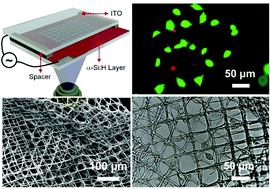Visible light induced electropolymerization of suspended hydrogel bioscaffolds in a microfluidic chip†
Abstract
The development of microengineered hydrogels co-cultured with cells in vitro could advance in vivo bio-systems in both structural complexity and functional hierarchy, which holds great promise for applications in regenerative tissues or organs, drug discovery and screening, and bio-sensors or bio-actuators. Traditional hydrogel microfabrication technologies such as ultraviolet (UV) laser or multiphoton laser stereolithography and three-dimensional (3D) printing systems have advanced the development of 3D hydrogel micro-structures but need either expensive and complex equipment, or harsh material selection with limited photoinitiators. Herein, we propose a simple and flexible hydrogel microfabrication method based on a ubiquitous visible-light projection system combined with a custom-designed photosensitive microfluidic chip, to rapidly (typically several to tens of seconds) fabricate various two-dimensional (2D) hydrogel patterns and 3D hydrogel constructs. A theoretical layer-by-layer model that involves continuous polymerizing–delaminating–polymerizing cycles is presented to explain the polymerization and structural formation mechanism of hydrogels. A large area of hydrogel patterns was efficiently fabricated without the usage of costly laser systems or photoinitiators, i.e., a stereoscopic mesh-like hydrogel network with intersecting hydrogel micro-belts was fabricated via a series of dynamic-changing digital light projections. The pores and gaps of the hydrogel network are tunable, which facilitates the supply of nutrients and discharge of waste in the construction of 3D thick bio-models. Cell co-culture experiments showed the effective regulation of cell spreading by hydrogel scaffolds fabricated by the new method presented here. This visible light enabled hydrogel microfabrication method may provide new prospects for designing cell-based units for advanced biomedical studies, e.g., for 3D bio-models or bio-actuators in the future.



 Please wait while we load your content...
Please wait while we load your content...